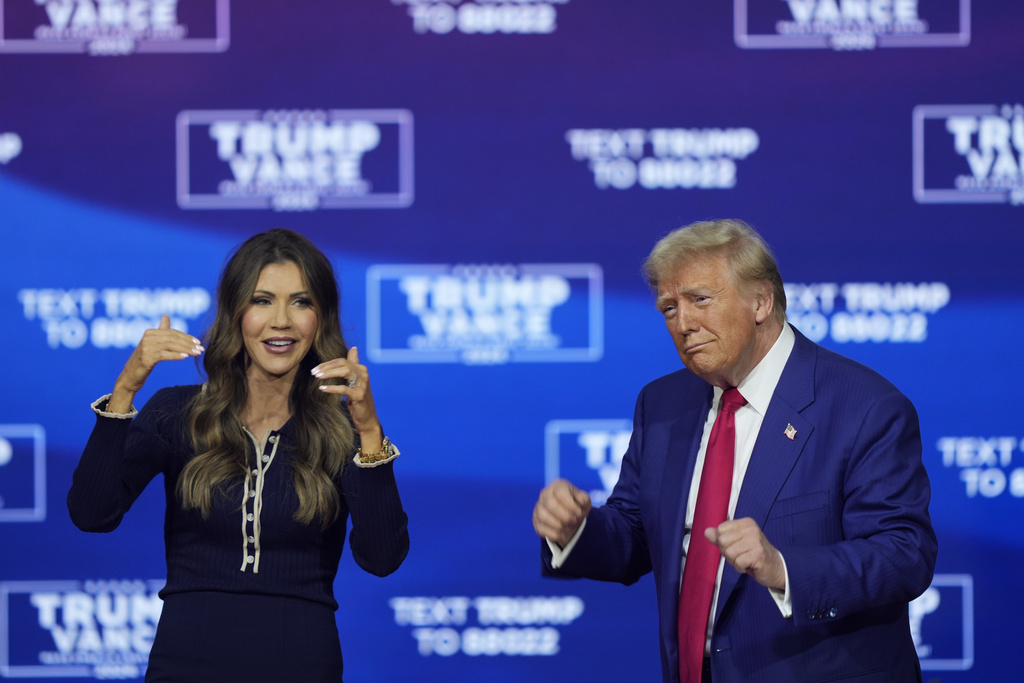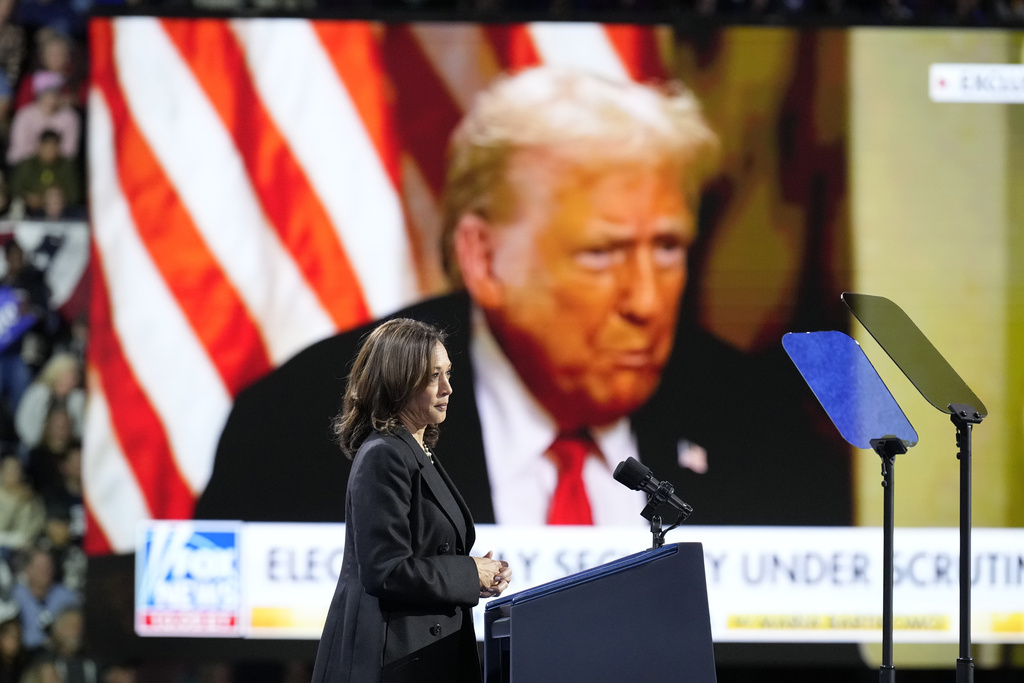How Trump and Harris Are Competing for the Male Vote in 2024 \ Newslooks \ Washington DC \ Mary Sidiqi \ Evening Edition \ As the Nov. 5 election approaches, Donald Trump and Kamala Harris are intensifying efforts to attract male voters. Trump’s campaign emphasizes traditional masculinity and hypermasculine rhetoric, while Harris’ team is focusing on targeted outreach through economic plans and community engagement. Both candidates are leveraging gender dynamics to sway undecided voters, particularly in key battleground states.

Trump and Harris Compete for the Male Vote: Quick Looks
- Masculine messaging: Trump’s campaign reinforces traditional gender roles and alpha-male rhetoric.
- Harris’ approach: The vice president focuses on economic incentives, outreach to Black and Hispanic men, and appeals to rural voters.
- Election dynamics: Both campaigns are capitalizing on gender and identity politics to win over small but crucial voter segments.
Deep Look
As the final stretch of the election season begins, Donald Trump and Vice President Kamala Harris are deploying sharply contrasting strategies to win over male voters. With polls showing tight races in key battleground states, the candidates are aiming to sway small but pivotal groups of men who remain undecided or unenthusiastic about their options.
Trump’s Hypermasculine Campaign Rhetoric
Donald Trump has doubled down on his hypermasculine persona, crafting a narrative that appeals to traditional gender roles and notions of alpha-male behavior. Through appearances on podcasts, gaming platforms, and rallies, Trump’s surrogates, including figures like Charlie Kirk, have framed a vote for Trump as a validation of masculinity. “If you are a man in this country and you don’t vote for Donald Trump, you’re not a man,” Kirk declared on his podcast, echoing the aggressive, direct messaging the campaign has employed.
Trump’s campaign, which has historically leaned into brash and sometimes crude rhetoric, continues to present him as a symbol of strength and resilience. In speeches, he has spoken about protecting women, drawing a link between masculinity and his promises to safeguard the nation. For example, during a rally in Aurora, Colorado, Trump said, “I think women like me because I will be your protector. The women want protection. They don’t want these people pouring in,” referencing his stance on immigration.
The former president also hasn’t shied away from using demeaning language against those he perceives as opponents. Recently, he took to his social media platform, Truth Social, to call radio host Howard Stern a “BETA MALE” and mock a female protester, suggesting she “go back home to Mommy.” These remarks, while controversial, are intended to reinforce a brand of unyielding masculinity that resonates with a portion of the electorate.
Harris’ Focus on Broader, Inclusive Male Outreach
Vice President Harris is tackling the same voter demographic with a different approach. Rather than leaning into traditional masculinity, Harris’ campaign is engaging men through targeted outreach efforts that include economic incentives and community engagement. She has announced proposals aimed specifically at improving economic opportunities for Black men, including forgivable loans for small business owners and apprenticeships to boost job prospects.
Harris has also taken a more casual, relatable approach to her public appearances, aligning herself with popular figures like radio host Charlamagne Tha God. She is set to participate in a town hall with him, targeting younger Black and Hispanic men who might feel disconnected from the political process. Additionally, her running mate, Tim Walz, has been involved in outreach to rural voters, even engaging in activities like pheasant hunting to appeal to traditional rural sensibilities.
Harris’ strategy has included organizing events like “Dudes for Harris,” “Hombres con Harris,” and “Black Men Huddle Up,” reflecting a conscious effort to reach male voters across different communities. By combining community-based outreach with policy proposals, her campaign is working to counteract stereotypes and broaden her appeal.
The Historical Context of Gender Politics in Elections
The efforts to sway male voters are not new but reflect a long history of gendered political strategies. Jackson Katz, author and creator of the film “The Man Card: 50 Years of Gender, Power & the American Presidency,” notes that Republicans have long capitalized on positioning their candidates as embodiments of traditional masculinity. Trump’s campaign is continuing this legacy, framing him as a figure of strength and decisiveness, qualities often associated with male leadership.
This tactic, according to Katz, creates a “soap opera for men” where Trump is positioned as a hero battling against what his supporters see as threats to American values. By leaning into the idea of a masculine protector, Trump’s rhetoric appeals to voters who feel nostalgia for a more traditional sense of male authority.
The Influence of Identity Politics on the 2024 Election
Gender dynamics and identity politics are playing a crucial role in this year’s election, with both campaigns trying to carve out support from specific voter segments. Young women, for instance, are becoming increasingly liberal, while young men do not show the same trend. Hispanic men are more divided in their support for Harris, unlike their female counterparts, who generally view her more favorably.
In the Democratic camp, concerns have arisen over Harris’ support among Black men, a key demographic that played a vital role in previous elections. Harris has taken steps to address this, launching initiatives that promote economic incentives and community engagement.
In the Republican camp, Trump’s campaign continues to focus on themes of strength, resilience, and traditional values. His approach is meant to resonate with men who may feel sidelined by cultural shifts associated with movements like MeToo and Black Lives Matter. These cultural and political dynamics create a nuanced playing field where even subtle shifts can have significant impacts on election outcomes.
Trump’s Continued Embrace of Traditional Masculinity
Even with his legal troubles and contentious political history, Trump has maintained a persona that exudes confidence and bravado. This was exemplified during his recovery from a shooting in July, where he famously emerged bloodied but defiant, shouting, “Fight, fight, fight!” His appeal to traditional masculinity has extended to promises of protection and order, a theme that resonates especially with suburban male voters.
Trump’s recent media appearances, including a scheduled all-female town hall on Fox News, show a strategic effort to balance his appeal to men with attempts to attract women voters who may have reservations about his past behavior. Despite these efforts, he often defaults back to the hypermasculine rhetoric that has become a cornerstone of his political identity.
Harris’ Plans to Expand Her Appeal
Kamala Harris, on the other hand, is stepping out of her ideological comfort zone. She has agreed to an interview on Fox News, a move that signals her willingness to reach across the aisle and engage with voters who might be skeptical of her platform. Her campaign’s outreach efforts are underscored by a more inclusive vision of masculinity, one that supports economic opportunities and promotes equity.
The Democratic ticket has rolled out a diverse strategy that attempts to bridge gaps with specific voting blocs. For instance, Tim Walz’s focus on rural voters and Harris’ connections with urban communities create a contrast to Trump’s predominantly male-centric narrative. Their strategy emphasizes community, cooperation, and inclusivity over division and confrontation.
Conclusion
As the Nov. 5 election draws nearer, the contrasting strategies of Donald Trump and Kamala Harris underscore a larger battle over gender and identity politics. Trump’s emphasis on traditional masculinity and tough-guy rhetoric appeals to a segment of the male electorate that feels connected to his assertive style. Meanwhile, Harris’ focus on inclusivity, community, and economic incentives offers a more nuanced approach to addressing male voters across various demographics. Both campaigns are vying for the support of small but crucial voter segments, knowing that a few percentage points could tip the scales in key battleground states.







